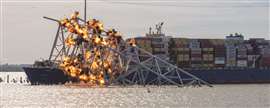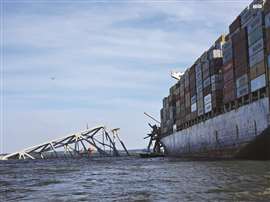Explosive Demolition: to be or not to be?
26 June 2024
Global media coverage of the recent Baltimore bridge disaster in the United States has shown the world how utilising explosives for demolition can be safe, precise, expedient and cost effective.
 The collapse of the Francis Scott Key Bridge required specialist Controlled Demolition Inc to conduct precision blasting to assist in the clean-up of the disaster. See full details below. (PHOTO: CDI)
The collapse of the Francis Scott Key Bridge required specialist Controlled Demolition Inc to conduct precision blasting to assist in the clean-up of the disaster. See full details below. (PHOTO: CDI)
But in the past 15 years, the method has come under intense scrutiny and, propelled by the digital age to all corners of the world, has sparked widespread debate.
Concerns over safety, environmental impact, and the potential for unintended damage have led to increased regulation and public scepticism.
Now add to that the possibility of litigation - a concern for all contractors but especially those in the United States.
Just last year, Mark Loizeaux, Owner and President US-based contractor Controlled Demolition Inc (CDI), drew attention to issue.
The impact of litigation on the demolition sector
Speaking at the 2023 World Demolition Summit in Toronto, Canada, Mark said: “No matter what you do, no matter what your undertaking is, you are going to get sued.”
For all the change that is happening in our sector, Mark said: “What’s not going to change is the regulatory propensity to back away from conflict with litigation.
“Right now, I’m in four lawsuits. Totalling over US$30 million. And on these projects I did exactly what I was supposed to do, in each one, without fail.
“And all of that litigation was a function of work that was outside my scope. And despite the fact that my contract says that my client will defend, indemnify and hold me harmless, and name me as additionally insured on their insurance by endorsement, for claims arising outside of my scope of work, it doesn’t stop me from getting sued.”
Mark concluded: “I honestly don’t know that there is going to be an explosives demolition industry in the United States in ten years [time].”
Demand for blasting services
The lawsuits filed against contractors is an enormous concern, and one that has long been a contributing factor to the decline of this specialist sector, along with workforce, economic and regulatory factors.
However, advancements in technology and technique continue to demonstrate that, when executed by skilled professionals, explosive demolition remains a vital and reliable method for safely and efficiently dismantling large structures.
And the good news is that many do recognise that - in some regions, such as Europe and Asia, the demand for the method is growing.
In Europe, despite the rising environmental legislation, the move towards sustainable energy is also driving energy companies to focus on the decommissioning of outdated, inefficient power plants and the construction of new, greener facilities.
This transition necessitates precise and efficient demolition methods, often making explosive demolition the preferred choice due to its speed and effectiveness.
In Asia, rapid urbanisation and infrastructure development are also leading to an increased need for the safe and swift removal of old buildings and industrial structures. Here, too, explosive demolition is gaining more and more traction as a viable solution to meet the stringent timelines and safety standards required for these large-scale projects.
As a result, while regulatory challenges and economic pressures remain, the demand for expert explosive demolition services is seeing a resurgence in these regions, offering a promising outlook for the sector’s future.
However, for those carrying out exolosive work, litigation will too likely remain a big issue.
Recent explosive demolition projects
CDI assists Baltimore bridge clean-up
Controlled Demolition Inc recently used explosives to clear a section of the Francis Scott Key Bridge in Baltimore, Maryland, which suffered a catastrophic collapse when the cargo ship M/V Dali collided with it on Tuesday 26 March.
 The scale of the truss members in relation to CDI personnel and the M/V Dali vessel can clearly be seen. (PHOTO: CDI)
The scale of the truss members in relation to CDI personnel and the M/V Dali vessel can clearly be seen. (PHOTO: CDI)
The precision blasting was part of a major dismantling and salvage operation, being carried out by a multi-agency taskforce, to clear both the fallen bridge and the disabled M/V Dali cargo vessel from the Patapsco River.
Since the disaster occurred, the M/V Dali vessel had remained pinned to the bottom of the river by the bridge truss, causing the Fort McHenry shipping channel to be partially blocked for over a month.
 Before the blast: The truss of the Francis Scott Key Bridge pinning the bow of the M/V Dali to the bottom of the Patapsco River. (PHOTO: CDI)
Before the blast: The truss of the Francis Scott Key Bridge pinning the bow of the M/V Dali to the bottom of the Patapsco River. (PHOTO: CDI)
Given the damaged and twisted condition of the fallen truss, extensive investigation and engineering design was required, before pre-cutting 52 cut points for the placement of 151 explosive charges could be safely performed by CDI.
Due to the presence of flammable materials on the vessel, fire retardant blankets and a fire suppression water mist were placed over the bow of the ship as a precautionary measure.
 The collapse of the Francis Scott Key Bridge required specialist Controlled Demolition Inc to conduct precision blasting to assist in the clean-up of the disaster. See full details below. (PHOTO: CDI)
The collapse of the Francis Scott Key Bridge required specialist Controlled Demolition Inc to conduct precision blasting to assist in the clean-up of the disaster. See full details below. (PHOTO: CDI)
CDI detonated the explosives on schedule at 17:00 hours on May 13, 2024.
Roughly 312 lbs of explosives were detonated over 9.6 milliseconds to ensure the linear charges severed the steel truss members, as needed, to accomplish total separation of the truss from the M/V Dali.
 After the blast: The separation after the shot freed the M/V Dali from the truss. (PHOTO: CDI)
After the blast: The separation after the shot freed the M/V Dali from the truss. (PHOTO: CDI)
The charge separation system worked as planned, removing the weight of the truss from the bow of the M/V Dali, and created the needed separation for the vessel to be refloated on May 20, 2024.
Felling a 200-metre-high chimney stack in Spain
Earlier this quarter, Lezama Demoliciones carried out two blastings at the Litoral Thermal Power Plant – the largest power plant owned by energy giant Endesa in southern Spain.
The site, which became operational in 1985 and - thanks to the addition of a second power generation unit in 1997, had a maximum energy production capacity of 1,159 MW. It is currently undergoing decommissioning works that will transform it into a renewable energy complex.
As part of the works, Lezama recently took down the plant’s chimney, which measured 200 m high and 19 m in diameter at its base.
The company employed a double mining technique to carry out the demolition, placing explosives at ground level and at a height of 96 m.
According to the Lezama, the split of explosives ensured that the chimney bent over itself as it fell, creating a shorter falling area.
“It is the first time this methodology has been used in Spain,” said Lezama. “As seen in the videos, everything went perfectly.”
Simultaneously to the felling of the chimney, the contractor also carried out a second explosive event on Litoral Thermal’s 40-metre-high desulphurization unit.
The metal structure was taken down using copper linear charges, which saw it hit the ground before the plant’s chimney.
CONNECT WITH THE TEAM




